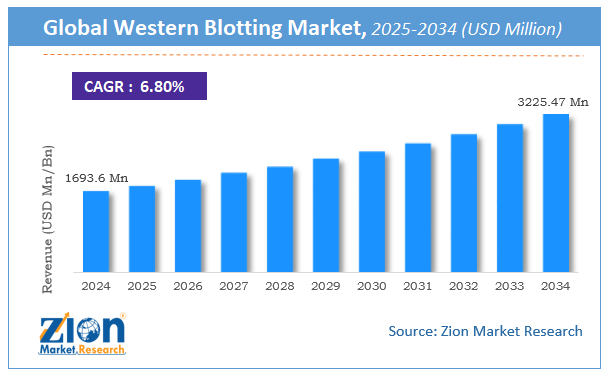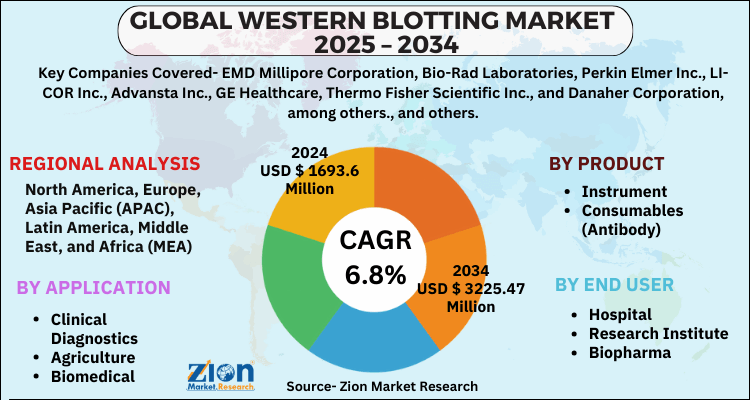Western Blotting Market Size, Share, Analysis, Trends, Growth, 2034

Global Western Blotting Market By Application (Clinical Diagnostics, Agriculture, and Biomedical), By Product (Instrument (Electrophoresis, Imager (Fluorescent), & Blotting System) and Consumables (Antibody)), By End-User (Hospital, Research Institute, and Biopharma), And By Region - Global and Regional Industry Overview, Market Intelligence, Comprehensive Analysis, Historical Data, and Forecasts 2025 - 2034
| Market Size in 2024 | Market Forecast in 2034 | CAGR (in %) | Base Year |
|---|---|---|---|
| USD 1693.6 Million | USD 3225.47 Million | 6.8% | 2024 |
Western Blotting Industry Perspective:
The global western blotting market size was worth around USD 1693.6 Million in 2024 and is predicted to grow to around USD 3225.47 Million by 2034 with a compound annual growth rate (CAGR) of roughly 6.8% between 2025 and 2034. The report analyzes the global western blotting market's drivers, restraints/challenges, and the effect they have on the demands during the projection period. In addition, the report explores emerging opportunities in the western blotting industry.
Global Western Blotting Market: Overview
The western blotting technique is extensively used in cell and molecular biology. With the help of this technique, researchers can identify a single protein from a mixture of complex proteins that are extracted from cells. There are 3 elements used in western blotting. The first step involves the separation of proteins based on size, followed by transferring of separated proteins to a solid support, and the last step involves marking the target protein with the help of primary & secondary antibodies.
In the last step, the primary antibody is generally either animal-derived or created synthetically, and is able to recognize and bind with the target protein. A solution containing the primary antibody is used to wash off the electrophoresis membrane. The secondary antibody that is visualized by either staining, radioactivity, or by immunofluorescence methods, then identifies and attaches itself to the primary antibody. The whole process allows for full-proof detection of the desired protein.
The global western blotting market has extensive use in biochemistry. More than 10% of publications based on proteins use the white blotting method and various software tools are used for the processing and alignment of the image captured for proper presentation of white blotting results.
Key Insights
- As per the analysis shared by our research analyst, the global western blotting market is estimated to grow annually at a CAGR of around 6.8% over the forecast period (2025-2034).
- Regarding revenue, the global western blotting market size was valued at around USD 1693.6 Million in 2024 and is projected to reach USD 3225.47 Million by 2034.
- The western blotting market is projected to grow at a significant rate due to increasing applications in proteomics and medical research.
- Based on Application, the Clinical Diagnostics segment is expected to lead the global market.
- On the basis of Product, the Instrument (Electrophoresis segment is growing at a high rate and will continue to dominate the global market.
- Based on the End-User, the Hospital segment is projected to swipe the largest market share.
- Based on region, North America is predicted to dominate the global market during the forecast period.
Global Western Blotting Market: Growth Drivers
Increasing use in the medical diagnosis of HIV to aid global market growth
The global western blotting market generates huge revenues because of western blotting’s application in the detection and diagnosis of HIV. The confirmatory test involves the employment of western blots to detect anti-HIV in the given human serum sample. The number of reported HIV medical cases has increased drastically in the last couple of years. More than 37 million of the world population was diagnosed with HIV in 2020 while the number of patients in 2010 was around 3 million. Another reason for the growth in HIV diagnostic tests is the rise in blood donations across the globe. The donated blood can only be safely used once it has passed the necessary tests, one of which is a test for HIV detection. This is anticipated to aid the global market growth in the coming years.
Western blotting tests are used as definitive tests that are conducted to confirm vCJD or commonly known as mad cow disease which spreads due to the consumption of beef that suffers from bovine spongiform encephalopathy. The growth in meat consumption and beef being a part of the staple diet in many nations has resulted in the increase in medical cases related to variant Creutzfeldt–Jakob disease thus propelling global market expansion.
Global Western Blotting Market: Restraints
Lack of skilled professions to restrict the global market growth
Working on western blotting technology requires extremely skilled professionals owing to the detailed, microscopic, and thorough nature of the technology. Since the results of these tests have strong implications on the medical data of patients, there is no room for error thus making a high degree of experimental optimization a necessity. Since there is a dearth of skilled professionals as compared to the rising demand and adoption of western blotting technology, the global market is expected to be restrained during the forecast period. This is also coupled with technological advancements in the global market like the launching of AlphaScreen technology which eliminates the washing steps thus becoming more time-efficient. However, there are not enough technicians capable of handling such advanced technology with accuracy and great efficiency.
Global Western Blotting Market: Opportunities
Rising automation in western blotting to provide growth opportunities during the forecast period.
Since we are currently at a stage where automation is increasingly being adopted in almost all fields, the global western blotting market has also witnessed a rise in automating many white blotting processes. There is a huge jump registered in software used for imaging results of western blotting. With the rising number of western blot tests, there is a growth in the subsequent data generated that is highly sensitive and needs technically rich systems to document these data. The systems provide for processing, organizing, and interpreting the collected data. Currently, due to the high cost of automated systems, the traditional western blotting technique is more in demand. However, if the cost factor can be reduced, the global market has higher growth opportunities in terms of automated processes.
Global Western Blotting Market: Challenges
Life cycle complexity of white blots to challenge the market expansion
Even though the white blotting technique has high use in molecular biology along with huge applications in research, the developmental life cycle of white blots is extremely complex rendering it difficult to be produced by small to medium-scale manufacturers. Domestic players with insufficient funds may not find it cost-effective thus making the global market lose potential consumers. A rise in the shift towards other technologies like RIBA or ELISA is witnessed in many countries which may pose a challenge for global market growth.
Global Western Blotting Market: Segmentation
The global western blotting market is segmented based on application, product, end-user, and region.
By application, the global market segments are clinical diagnostics, agriculture, and biomedical, and is anticipated to be dominated by the rising application in the biomedical segment. This is owed to the increased funding received from government agencies especially on proteomics research along with the rising need for white blogs in the pharmaceutical sector during the drug development process.
By product, the global market is segmented into instruments and consumables. The instrument segment is divided into electrophoresis, imager (fluorescent), and blotting systems. The consumables segment is showing healthy signs of high global market growth because of the rise in diseases that require white blotting technology for detection. The blotting system may also register high revenue because of its properties like high efficiency and sensitivity along with lesser run time.
By end-user, hospital, research institute, and biopharma are the global market segments. Research institutes may lead the global market during the projection period.
Recent Developments
- In July 2020, SARS-CoV-2 was launched by Bio-Techne Corporation. The launched product is a multi-antigen serology module specially designed for the Jess and Simple Western automate a system that uses white blotting technology. The technology aided the accelerated research and vaccine development during Covid-19 by systematically characterizing the response of the human immune system to various SARS-CoV-2 antigens.
- In July 2020, virology researchers were supported extensively by LI-COR Biosciences to understand Covid-19 and other viruses with the help of well-established products, services, and tools. Some of the technology used was the near-infrared western blots and in-cell western assays to study the virus.
Western Blotting Market: Report Scope
| Report Attributes | Report Details |
|---|---|
| Report Name | Western Blotting Market |
| Market Size in 2024 | USD 1693.6 Million |
| Market Forecast in 2034 | USD 3225.47 Million |
| Growth Rate | CAGR of 6.8% |
| Number of Pages | 210 |
| Key Companies Covered | EMD Millipore Corporation, Bio-Rad Laboratories, Perkin Elmer Inc., LI-COR Inc., Advansta Inc., GE Healthcare, Thermo Fisher Scientific Inc., and Danaher Corporation, among others., and others. |
| Segments Covered | By Application, By Product, By End-User, and By Region |
| Regions Covered | North America, Europe, Asia Pacific (APAC), Latin America, The Middle East and Africa (MEA) |
| Base Year | 2024 |
| Historical Year | 2020 to 2023 |
| Forecast Year | 2025 - 2034 |
| Customization Scope | Avail customized purchase options to meet your exact research needs. Request For Customization |
Global Western Blotting Market: Regional Analysis
North America to continue dominating the global market
The global western blotting market generates the highest revenue from North America since the USA is the hub of western blotting technology. The trend is expected to continue in the coming years mainly due to the highly advanced medical diagnostic and biotechnical sector in the region. As per reports submitted by the USDA, the adoption of western blotting in agriculture biotechnology is anticipated to aid regional growth.
Asia-Pacific and Europe are also showing excellent signs of steady growth in the coming years mainly due to the exponential rise in the pharmaceutical industry in these regions. As per the Government of China, the total revenue in pharmaceutical and dietary segments was over $120 Billion in 2018 and has only grown since then.
Global Western Blotting Market: Competitive Analysis
The report provides a company market share analysis to give a broader overview of the key market players. In addition, the report also covers key strategic developments of the market, including acquisitions & mergers, new product launches, agreements, partnerships, collaborations & joint ventures, research & development, and regional expansion of major participants involved in the western blotting market on a global and regional basis.
The global western blotting market is dominated by players like
- EMD Millipore Corporation
- Bio-Rad Laboratories
- Perkin Elmer Inc.
- LI-COR Inc.
- Advansta Inc.
- GE Healthcare
- Thermo Fisher Scientific Inc.
- Danaher Corporation.
The global western blotting market is segmented as:
By Application
- Clinical Diagnostics
- Agriculture
- Biomedical
By Product
- Instrument
- Electrophoresis
- Imager (Fluorescent)
- Blotting System
- Consumables (Antibody)
By End-User
-
Hospital
- Research Institute
- Biopharma
By Region
- North America
- The U.S.
- Canada
- Europe
- France
- The UK
- Spain
- Germany
- Italy
- Rest of Europe
- Asia Pacific
- China
- Japan
- India
- South Korea
- Southeast Asia
- Rest of Asia Pacific
- Latin America
- Brazil
- Mexico
- Rest of Latin America
- Middle East & Africa
- GCC
- South Africa
- Rest of Middle East & Africa
Table Of Content
Methodology
FrequentlyAsked Questions
The western blotting technique is extensively used in cell and molecular biology. With the help of this technique, researchers can identify a single protein from a mixture of complex proteins that are extracted from cells. There are 3 elements used in western blotting.
The global western blotting market is expected to grow due to rising applications in proteomics research, increasing prevalence of infectious diseases, and demand for biomarker detection in diagnostics.
According to a study, the global western blotting market size was worth around USD 1693.6 Million in 2024 and is expected to reach USD 3225.47 Million by 2034.
The global western blotting market is expected to grow at a CAGR of 6.8% during the forecast period.
North America is expected to dominate the western blotting market over the forecast period.
Leading players in the global western blotting market include EMD Millipore Corporation, Bio-Rad Laboratories, Perkin Elmer Inc., LI-COR Inc., Advansta Inc., GE Healthcare, Thermo Fisher Scientific Inc., and Danaher Corporation, among others., among others.
The report explores crucial aspects of the western blotting market, including a detailed discussion of existing growth factors and restraints, while also examining future growth opportunities and challenges that impact the market.
RelatedNews
HappyClients
Zion Market Research
Tel: +1 (302) 444-0166
USA/Canada Toll Free No.+1 (855) 465-4651
3rd Floor,
Mrunal Paradise, Opp Maharaja Hotel,
Pimple Gurav, Pune 411061,
Maharashtra, India
Phone No +91 7768 006 007, +91 7768 006 008
US OFFICE NO +1 (302) 444-0166
US/CAN TOLL FREE +1 (855) 465-4651
Email: sales@zionmarketresearch.com
We have secured system to process your transaction.
Our support available to help you 24 hours a day, five days a week.
Monday - Friday: 9AM - 6PM
Saturday - Sunday: Closed






